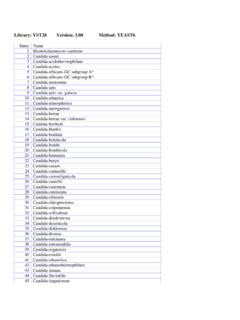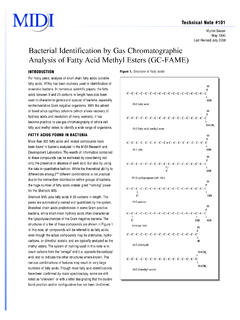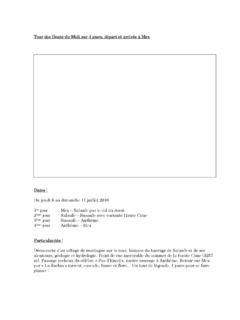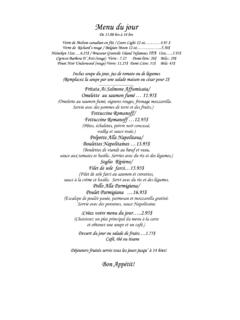Transcription of FOR THE SHERLOCK MIS - MIDI, Inc.
1 FATTY ACID PROFILING. BY GAS CHROMATOGRAPHY. FOR THE SHERLOCK MIS. Traditional gas chromatography of complex mixtures of compounds SHERLOCK uses a simple sample preparation procedure and gas requires precision on the part of the chromatography equipment and chromatography (GC) to yield qualitatively and quantitatively considerable operator skill. Variations in oven temperature, carrier gas reproducible fatty acid composition profiles. Following are some flow rates, column lengths and liquid phase conditions cause run-to-run terms and explanations to help you navigate those profile reports. and machine-to-machine variations, which limit precision and productivity.
2 Equivalent Chain Lengths (ECL) Values After analysis, the data transfer and data handling for anything other than SHERLOCK 's peak naming methodology uses the composition of the simple reports may require interfacing the system with generic software calibration standard to continually monitor the health of the system. packages to obtain the complete data analysis you desire. The Microbial ID calibration mix for non-bacterial or eukaryotic analysis, The SHERLOCK MIS is designed to not only improve the quality of chro- for example, is composed of a series of saturated fatty acids of chain matographic results, but is also integrated all the way through indexing lengths from 9:0 to 30:0 as well as other diagnostic compounds.
3 The of samples analyzed, cluster analysis and pattern recognition searches entry into the peak naming table of the Equivalent Chain Lengths (ECL). of databases. The Agilent ChemStation is the analytical heart of the midi . values for all of the peaks in the calibration mix permits the software to SHERLOCK system. The ChemStation provides automated sample analysis automatically calculate a "nominal retention time" for each peak. The and stores the data file. The SHERLOCK software provides greater flexibility calibration mixture is composed of compounds having the same general by organizing information in name fields.
4 It uses the external calibration chromatographic properties. The saturated fatty acids are assigned an analysis to improve precision of peak naming. It also contains diagnos- ECL value corresponding to their length ( 11:0 = ECL ). tic features which monitor the chromatographic performance and stan- Compounds that elute from the column at ECL values below those dardize the results. The ChemStation data are used for peak naming by of known compounds would be assigned an interpolated ECL value. the SHERLOCK software and the results are stored in a SHERLOCK data file. These data files may be sorted by the SHERLOCK indexing program and are then used by the principal component and multivariate analysis clus- tering programs and by the pattern recognition database search program.
5 ECL Deviation Report Each printout of an analysis indicates the ECL value of each peak and the deviation from the expected value. This is shown in the partial report below under Comment 1 . ECL Name % Comment 1 Comment 2. 16:1 w7c ECL deviates 16:1 w6c ECL deviates 16:1 w5c ECL deviates 16:0 ECL deviates Sum in Feature 4 ECL deviates 17:1 ISO I /ANTEI B. For the peak 16:1 w7c (above), an ECL of is reported, as is ECL Deviates . The minus sign and value indicates that the peak is emerging faster than expected by one thousandth of an ECL value (expected = ). Peaks in the early part of the analysis are more affected by GC oven temperatures and those later in the analysis are more severely impacted by carrier gas flow rates.
6 The use of the Agilent programmable electronic pressure controller to achieve constant flow minimizes the latter type of error. Peak Shape Rejection In analysis of materials such as fatty acids, the extraction procedure may carry over sterols and other non-fatty acid materials. Additionally, electronic noise may result in transient spikes, which might interfere with the chromatography. Fatty acid peaks always have area/height ratios greater than and less than , making it possible to set exclusionary parameters at these levels. Electronic noise spikes are typically less than and non-fatty acid peaks (carryover, sterols, etc.)
7 Are usually greater than , allowing rejection of these artifacts. Summed Features In an ideal world, all peaks would be clearly resolved and no data would ever be lost due to inability of the chromatographic separation process. Practicality constraints like limited run time force acceptance of less than perfect chromatography. It is essential to not misname peaks. The SHERLOCK approach is to use a Summed Feature wherever imperfect peak separation occurs. Both compounds will be named in the comment field to the right of the report (see Comment 2 in the partial report on page 1). The one closest to the observed ECL.
8 Will be listed first. In the majority of cases this is the correct name for the compound, but both names are always included as a single feature. This avoids using incorrect peak names in the cluster analysis or pattern recognition programs of SHERLOCK . Nomenclature of Fatty Acids Straight Chain The figure above represents the straight chain fatty acid palmitic acid, written as 16:0. The 16 represents the number of carbons in the compound. The number after the colon indicates the number of double bonds in the carbon chain, in this case none. The carboxyl group (COOH) is at the right. These compounds may also be written with the letter C in front of the number.
9 For example 16:0 can be equivalently written C16:0. The letter C stands for carbons in the compound. Unsaturated 1. cis conformation omega alpha . end end The designation 16:1 indicates that the compound has 16 carbons and 1 double bond. The figure above represents the unsaturated fatty acid 16:1 w7c. Note that both hydrogens at the double bond are on the same side in cis conformation. The w7c notation refers to the 7th carbon from the omega or end of the chain; the carboxyl group is located at the alpha end. This compound may have been repre- sented as 16:1 cis 9 in other literature. 2. trans conformation This figure above represents the unsaturated fatty acid 16:1 w7t.
10 Note that the hydrogens at the double bond are on opposite sides of the compound in trans conformation. Iso The figure above represents the fatty acid 17:0 ISO. A methyl group occurs at the second to the last carbon in the chain. Anteiso The figure above represents the fatty acid 17:0 ANTE ISO. A methyl group occurs at the third to the last carbon in the chain. Cyclopropane This represents the fatty acid 17:0 CYCLO w7c. In other literature it may be named as 17:0 CYCLO 9-10. This compound is made from 16:1. w7c with the addition of the carbon group at the double bond position. Dimethyl acetal This figure above represents dimethyl aldehyde 16:0, written as 16:0 DMA on the MIS printed reports.








